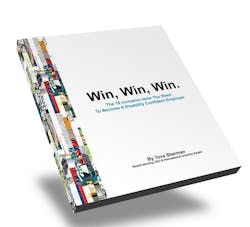How to Become a Disability-Confident Employer
Tova Sherman doesn’t let things get in her way.
When a friend lost a job, she was determined to find him another one. Given he worked in manufacturing and wanted to continue in the field, she approached a company she knew. They were interested until she mentioned he only had one arm. They said the job couldn’t be done with that restriction. Not true, she said and set out to prove it. She and her husband created a structure that allowed him to do the job with one arm. That man is still happily employed with the company eight years later.
Overcoming employers’ objections is Sherman’s mission. As CEO OF reachAbility, a Canada-based organization that partners with public, private, and non-governmental agencies to create an equal playing field, Sherman is trying to correct outdated thinking
“Throughout our lives, we have been taught, through school, the media and other people, that those with disabilities have ‘medical’ problems and therefore we don’t feel comfortable around them. But through education and osmosis we can change that,” Sherman says.
Education can take a variety of forms. “It’s not that people don’t want to hire the disabled, they just don’t know how or what to do and are nervous about making errors,” she says. “I do think that the pandemic has changed many employers' perspectives in terms of realizing that employees can figure out ways to accommodate their needs and get the job done. This is especially true for the disabled who have created home environments that are conducive to a variety of work.”
Whether it's hiring those who can work at home or outfitting a physical location, which Sherman says often costs less than $500, the larger concern most people have is that they are unsure how to act around those with disabilities.
During her public lectures, she gives the example of how people in wheelchairs do not like others to touch the chairs, as they view the chair as an extension of themselves. But often people offer to push others. “Once you have worked with those with disabilities you learn through osmosis, how to act and that will clear up a lot of fear people have,” Sherman says.
Sherman explains that there are many myths that are keeping people with disabilities out of the workplace. “Employers should be thinking that this group can expand their talent pool, but often they’re thinking they’re going to get sued if they do something wrong. They think they’re going to have more sick days, which studies have proved isn't true. However, I do believe people want to be inclusive. They just don’t understand how much bias is getting in the way."
The first step is to acknowledge that unconscious bias exists. Over one in three people show an unconscious bias against those with a disability, higher than levels of bias on the basis of gender or race. That thinking translates into a lack of job opportunities. In 2020, only 17.9% of persons with a disability were employed, compared to 61.8% of those without a disability, according to the U.S. Bureau of Labor Statistics.
“What's particularly upsetting about these low numbers of employment is that those with disability make for very strong employees. They take fewer sick days, are more productive and very dedicated to their jobs,” explains Sherman.
And companies that hire those with disabilities, experience strong financial benefits. According to a 2018 report from Accenture, companies that prioritized the inclusion of individuals with disabilities were:
- four times more likely to outperform their competitors in shareholder returns
- showed 28% higher revenue
- doubled their net income
- saw 30% higher profit margins
This inclusion had a positive effect on the total workforce as well. A Department of Labor study found that employers who embraced disability saw a 90% increase in employee retention.
Becoming a Disability-Confident Employer
To help employers bring this talent pool into their workplaces, Sherman recently authored the book, Win, Win, Win: The 18 Inclusion-isms You Need to be a Disability Confident Employer (2021). Each “inclusion-ism” provides background on the issue, offers ways to implement new policies and suggests "in practice" actions.
Her organization, founded 25 years ago, offers employers a variety of useful tools to become a disability-confident employer. Using a solution-based method of customized training, the organization devises an action plan based on the company's specific challenges. The tailored workshops and training modules are designed to create a shift in how organizations engage in initiatives related to accessibility, diversity, and inclusion.
“This process will allow society to move from the medical paradigm to a social or human rights paradigm. We need to embrace this win-win-win philosophy. We need to be inclusive, expand our talent pool and then we'll expand our world as it will be diverse thinking that's going to move us forward as a society,” said Sherman.


